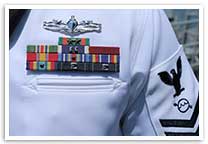
Navy Personnel are at Risk for Developing Mesothelioma
Veterans from all branches of the armed forces including the Army, Navy, Air Force and Marines are at risk for developing mesothelioma due to asbestos exposure sustained while on active duty serving their country. Mesothelioma Navy cases, however, are typically those recognized as the most common. Over time, these military veterans and particularly, Navy veterans and shipyard workers, have demonstrated a higher rate of developing mesothelioma than individuals with no military or navy history. These brave men and women, who so honorably served our country from World War II through the Vietnam War, were unknowingly exposed to high levels of airborne asbestos dust throughout their tours of duty. Until the late 1970’s and early 1980’s, products containing asbestos were made and used extensively in military establishments and on Navy warships and submarines. Warships were constructed using many types of asbestos containing products including pipe-fittings, gaskets, cables, cement, joint compound and boiler insulation just to name a few. Military vehicles were equipped with asbestos containing gaskets, clutches and brakes. When constructing buildings on our nation’s army bases floor covering materials, cement mixtures and plumbing systems frequently contained asbestos based products. Exposed insulation and airborne dust from grinding and sanding or ongoing maintenance procedures all created dangerous opportunities for Navy veterans to be exposed to asbestos.
Asbestos is a naturally occurring mineral that possesses exceptional heat and fire resistant properties and is relatively inexpensive to produce. Once the dangers of asbestos exposure became incontestable in the early 80’s, however, the Navy and military in general curtailed the use of asbestos containing products. Because Navy warships and military establishments remain ”in service” for many years, however, they continue to harbor asbestos containing parts and materials that present exposure risks even today in any type of asbestos removal project or maintenance and repair effort. As a result, present day military personnel may still be at risk for asbestos exposure although many safety precautions have been put in place to minimize their risk.
Navy Ships and Shipyard Workers
Many Navy veterans who were responsible for building and maintaining warships are reported to be at particularly high risk for developing mesothelioma or other asbestos cancer diseases. This is because many different types of products containing asbestos were used on the ships and the ventilation systems were very poor. Consequently these Navy personnel were frequently exposed to highly concentrated levels of asbestos dust in fire and engine rooms, boiler rooms, navigation rooms, mess halls and sleeping quarters. In fact, because signs of malignant mesothelioma may not show up for 30 to 40 years after being exposed to asbestos, it is only recently that a rise in the number of mesothelioma cases among Navy veterans and shipyard workers is being reported.
Navy veterans who worked below deck on naval warships or submarines are those most likely to develop mesothelioma due to asbestos exposure. They worked (and sometimes lived) in extremely tight quarters with dangerously high levels of asbestos dust lingering in the air. Poor ventilation systems prevented adequate air exchange and resulted in highly concentrated levels of asbestos to remain in the air for Navy personnel to breathe in. Unfortunately, because Navy veterans and shipyard workers carried the asbestos dust and fibers home on their clothes it is not uncommon for loved ones, particularly those responsible for handling the laundry, to also find that they have been diagnosed with mesothelioma.
Where Was Asbestos Found Aboard Navy Ships?
Asbestos could be found in nearly any area of a naval ship, as it served myriad uses within these vessels. However, most often, asbestos was used in an insulation capacity. Some of the areas asbestos was found include boiler/steam valves, piping, and related fixtures. Those who worked closest to asbestos within vessels were often those who conducted repairs of this type of fixtures. Oftentimes, the repairs of these materials necessitated disturbing older products by chipping and grinding- which would release asbestos fibers into the surrounding air. Because of this, it is not unusual for those who have worked extensively aboard naval ships or in naval shipyards to develop asbestos-related health complications like pleural mesothelioma, asbestosis, and other respiratory conditions as a result of exposure to asbestos.
Those who have knowingly worked with asbestos product, and particularly those who worked with products in the capacity discussed above, should be aware of the warning signs of mesothelioma disease and other asbestos related health complications. Mesothelioma symptoms closely mimic those associated with other respiratory conditions (including the common cold or chronic cough) but those who have worked with asbestos should share their asbestos exposure history and mesothelioma risk factors with their doctor or oncologist to ensure that they identify possible asbestos-related health complications.
Mesothelioma Navy Legal Rights
If you are a Navy veteran or if you served in another branch of the armed forces or at a Naval shipyard and have been diagnosed with mesothelioma cancer you may be eligible to receive compensation for your injuries.






No comments:
Post a Comment